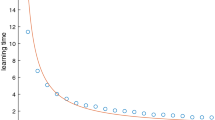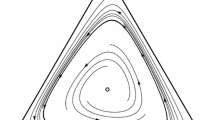Abstract
Although a large and growing literature has emerged to study evolutionary selection in finite populations recently, there is rare consideration on the effects of learning mechanisms’ heterogeneity. Based on a selection-mutation Moran process, this paper makes an attempt to construct and analyze a stochastic evolutionary game dynamic in two heterogeneous populations. Precisely speaking, one population is clever in the sense that its every individual mutates according to a pairwise comparison rule while the other is simple since each of its individuals mutates completely randomly. As a criterion of equilibrium selection, related stationary distributions of strategies are then analytically derived under weak selection. Besides, some novel findings can be obtained due to the explicit consideration of rational behavior. For example, it turns out that for coordination games the introduction of the rationality may inhibit the clever population from selecting the risk-dominant strategy, which is inconsistent with our common sense.






Similar content being viewed by others
References
Antal, T., & Scheuring, I. (2006). Fixation of strategies for an evolutionary game in finite populations. Bulletin of Mathematical Biology, 68, 1923–1944.
Ania, A. B. (2008). Evolutionary stability and Nash equilibrium in finite populations, with an application to price competition. Journal of Economic Behavior and Organization, 65, 472–488.
Allen, B., & Rosenbloom, D. I. S. (2012). Mutation rate evolution in replicator dynamics. Bulletin of Mathematical Biology, 74, 2650–2675.
Alpcan, T., & Basar, T. (2010). Network security: A decision and game-theoretic approach. Cambridge: Cambridge University Press.
Ba, S., Whinston, A. B., & Zhang, H. (2000). The dynamics of the electronic market: An evolutionary game approach. Information Systems Frontiers, 2, 31–40.
Bomze, I. M., & Burger, R. (1995). Stability by mutation in evolutionary games. Games and Economic Behavior, 11, 146–172.
Brown, G. W., & Von Neumann, J. (1950). Solutions of games by differential equations. Annals of Mathematics Studies, 24, 73–79.
Cerqueti, R., Correani, L., & Garofalo, G. (2013). Economic interactions and social tolerance: A dynamic perspective. Economics Letters, 120, 458–463.
Chatterjee, K., Zufferey, D., & Nowak, M. A. (2012). Evolutionary game dynamics in populations with different learners. Journal of Theoretical Biology, 301, 161–173.
Chalub, F. A. C. C., & Souza, M. O. (2008). Discrete versus continuous models in evolutionary dynamics: From simple to simpler-and even simpler-models. Mathematical and Computer Modelling, 47, 743–754.
Conlisk, J. (1980). Costly optimizers versus cheap imitators. Journal of Economic Behavior and Organization, 1, 275–293.
Daniel, G., Arce, M., & Sandler, T. (2003). An evolutionary game approach to fundamentalism and conflict. Journal of Institutional and Theoretical Economics, 159, 132–154.
Friedman, D. (1991). Evolutionary games in economics. Econometrica, 59(3), 637–666.
Geng, X., Whinston, A. B., & Zhang, H. (2004). Health of electronic communities: An evolutionary game approach. Journal of Management Information Systems, 21, 83–110.
Güth, W., & Kliemt, H. (2003). An evolutionary game approach to fundamentalism and conflict: Comment. Journal of Institutional and Theoretical Economics, 159, 155–162.
Heller, D. (2004). An evolutionary approach to learning in a changing environment. Journal of Economic Theory, 114, 31–55.
Hehenkamp, B., & Kaarbøe, O. M. (2008). Imitators and optimizers in a changing environment. Journal of Economic Dynamics and Control, 32, 1357–1380.
Hofbauer, J., & Sigmund, K. (1998). Evolutionary games and population dynamics. Cambridge: Cambridge University Press.
Hofbauer, J., & Sandholm, W. H. (2002). On the global convergence of stochastic fictitious play. Econometrica, 70, 2265–2294.
Hofbauer, J., & Sandholm, W. H. (2009). Stable games and their dynamics. Journal of Economic Theory, 144, 1665–1693.
Josephson, J. (2009). Stochastic adaptation in finite games played by heterogeneous populations. Journal of Economic Dynamics and Control, 33, 1543–1554.
Lahkar, R., & Sandholm, W. H. (2008). The projection dynamic and the geometry of population games. Games and Economic Behavior, 64, 565–590.
Long, C., Zhang, Q., Li, B., Yang, H., & Guan, X. (2007). Non-cooperative power control for wireless Ad Hoc networks with repeated games. IEEE Journal on Selected Areas in Communications, 25, 1101–1112.
Maynard Smith, J., & Price, G. (1973). The logic of animal conflicts. Nature, 246, 15–18.
Nanĕz, E. C., Garcia, A., & Li, C. (2008). A game-theoretic approach to efficient power management in sensor networks. Operation Research, 56, 552–561.
Nowak, M. A., Sasaki, A., Taylor, C., & Fudenberg, D. (2004). Emergence of cooperation and evolutionary stability in finite populations. Nature, 428, 646–650.
Ohtsuki, H. (2010). Stochastic evolutionary dynamics of bimatrix games. Journal of Theoretical Biology, 264, 136–142.
Saez-Marti, M. (1997). On the asymptotic convergence to mixed equilibria in \(2\times 2\) asymmetric games. International Journal of Game Theory, 26, 549–559.
Schipper, B. C. (2009). Imitators and optimizers in Cournot oligopoly. Journal of Economic Dynamics and Control, 33, 1981–1990.
Sekiguchi, T. (2013). General conditions for strategy abundance through a self-referential mechanism under weak selection. Physica A, 392, 2886–2892.
Smith, M. J. (1984). The stability of a dynamic model of traffic assignment-an application of a method of Lyapunov. Transportation Science, 18, 245–252.
Sandholm, W. H. (2001). Potential games with continuous player sets. Journal of Economic Theory, 97, 81–108.
Sandholm, W. H. (2005). Excess payoff dynamics and other well-behaved evolutionary dynamics. Journal of Economic Theory, 124, 149–170.
Sandholm, W. H. (2009). Large population potential games. Journal of Economic Theory, 144, 1710–1725.
Sandholm, W. H. (2010). Local stability under evolutionary game dynamics. Theoretical Economics, 5, 27–50.
Sandholm, W. H., Dokumacı, E., & Lahkar, R. (2008). The projection dynamic and the replicator dynamic. Games and Economic Behavior, 64, 666–683.
Traulsen, J., Claussen, C., & Hauert, C. (2005). Coevolutionary dynamics: From finite to infinite populations. Physical Review Letters, 95, 238701.
Uehara, T., & Iwasa, Y. (2010). Global mutations and local mutations have very different effects on evolution, illustrated by mixed strategies of asymmetric binary games. Journal of Theoretical Biology, 262, 223–231.
Weibull, J. (1995). Evolutionary game theory. Cambridge: MIT Press.
Zhang, Y., Mei, S., & Zhong, W. (2011). Stochastic evolutionary selection in finite populations. Economic Modelling, 28, 2743–2747.
Zhang, Y., Mei, S., & Zhong, W. (2012). Equilibrium selection under evolutionary game dynamics with optimizing behavior. Communications in Nonlinear Science and Numerical Simulation, 17, 3719–3726.
Acknowledgments
We wish to thank two anonymous referees for constructive comments that helped to substantially improve the quality and presentation of this manuscript.
Author information
Authors and Affiliations
Corresponding author
Appendix
Appendix
Proof of Proposition 1
It can be observed that the selection-mutation Moran process reduces to the model by Ohtsuki (2010) when \(w=0\). It thus follows from Ohtsuki (2010) that
By virtue of Eq. (12), it is not difficult to derive
Hence,
Some simple calculations show that
The proof can be completed by means of Eq. (14)–(16) and Eq. (11).
Rights and permissions
About this article
Cite this article
Zhang, Y., Gao, X. Stochastic Evolutionary Selection in Heterogeneous Populations for Asymmetric Games. Comput Econ 45, 501–515 (2015). https://doi.org/10.1007/s10614-014-9435-x
Accepted:
Published:
Issue Date:
DOI: https://doi.org/10.1007/s10614-014-9435-x
Keywords
- Stochastic evolutionary dynamic
- Asymmetric game
- Heterogeneous populations
- Moran process
- Finite populations




